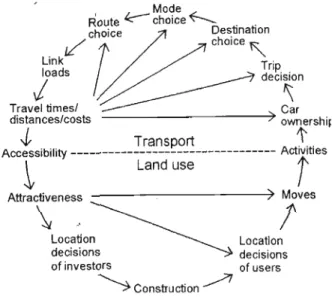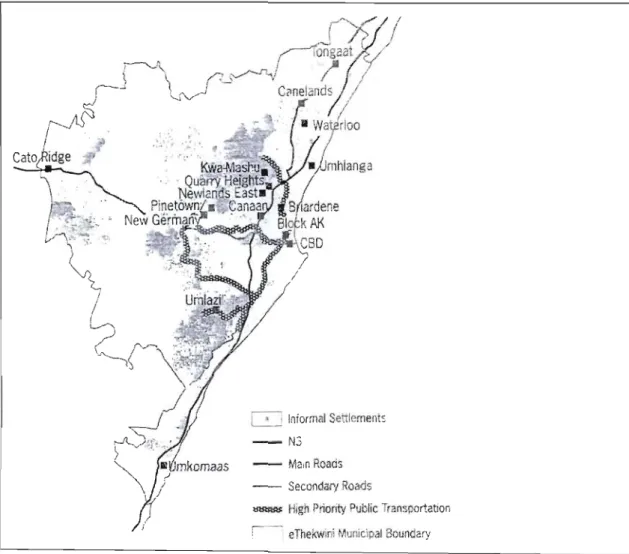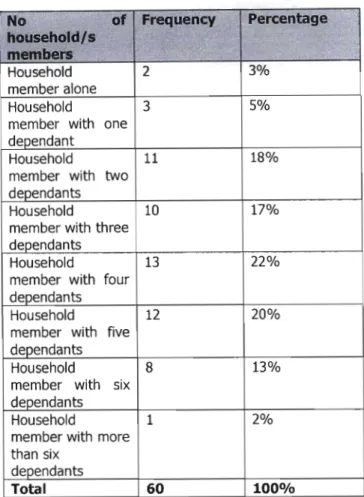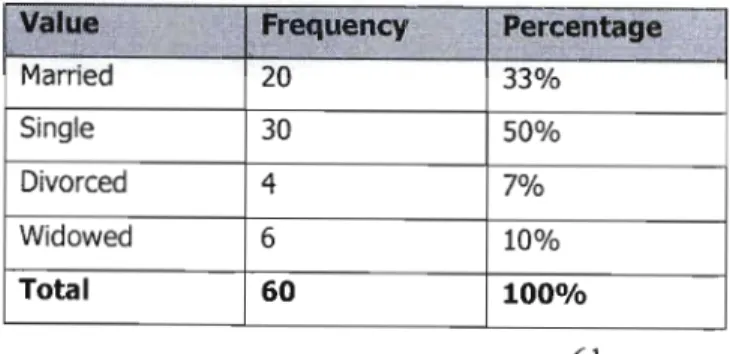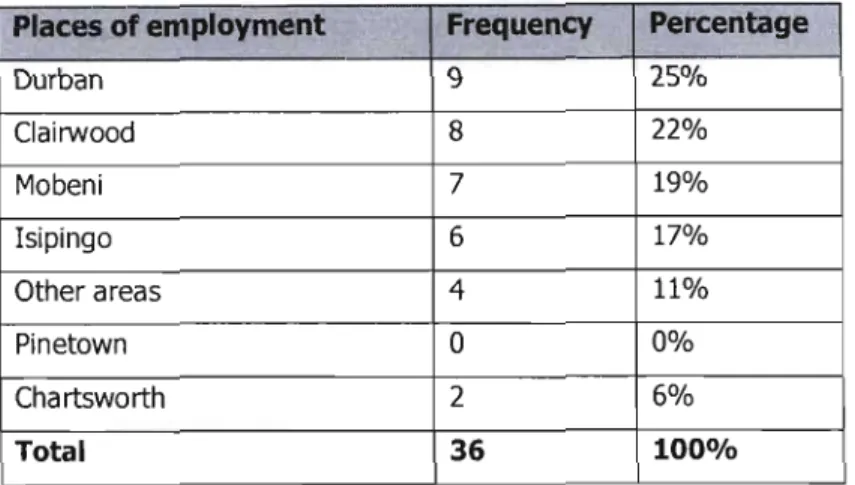The study area was chosen because it is one of the largest slum clearance projects in the eThekwini Municipality (Durban) and is on the outskirts. Its fundamental objective is to focus on the effects and impact of the marginal location of low-income housing projects.
Problem statement
Aucamp and Moodley (2002) argue that the eThekwini Municipality is faced with a situation where current and proposed subsidized low-income housing projects are often poorly located and reinforce the apartheid land use structure. The taxi industry, which is the main mode of passenger transport in WE, is currently not subsidized and therefore there is no government control to create mechanisms for operators to meet the community's travel needs.
Research Question
Key issues or subsidiary questions
What are the implications of relocation in terms of cost and travel time, and how does this compare with those aspects in the area of previous residence. What are the residents' perceptions of the new area and life in it, compared to their life in the previous area.
The need for choosing this study
Purpose of the study
Hypothesis
Case study
Research methodology
LOCALITY PLAN
- Primary data collection
- Secondary data collection
- Data analysis and presentation
- Definition of key concepts
- Limitations of the study
For the purposes of this study, only displaced beneficiary households formed part of the respondents. Low income housing can be defined within the framework of the Housing White Paper from (HWP) 1994.
CHAPTER TWO
Spatial development and racial segregation in human settlement
The history of spatial development and human settlement in South Africa dates back to the 16th century. The spatial development of the colonial city can be perceived as the roots of urban apartheid.
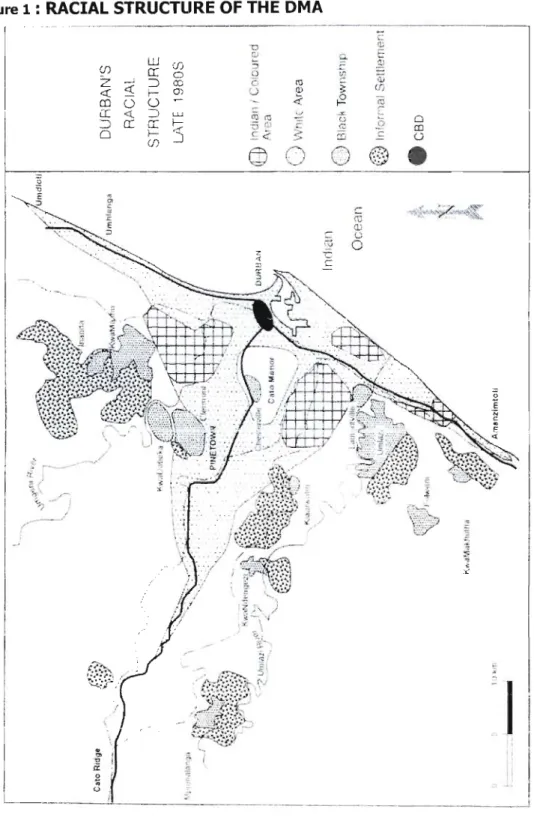
The problem of informal settlements
The visible disparity between informal settlements and the surrounding formal areas typically gives rise to social tension and fuels crime. The youthful, unemployed and male demographic profile of informal settlements has led to the emergence of gangs and high levels of violent crime.
The conflict between sprawl and compact city ideals
The idea of compacting cities, and thereby limiting outward expansion, has been proposed as a solution to the problem of urban fragmentation and sprawl that is often perpetuated by the poor location of low-income housing projects. As noted, the main goal of the housing sector is to provide as many houses as possible with available funds.
Integrated housing and location issues
This resulted in many marginalized settlements where, according to the intended beneficiaries, survival would simply be too difficult. Increasingly, however, the diminishing role of formal jobs in the lives of the poor and the growing importance of the type of income generation and livelihood strategies and the connection between these and the home environment are being recognised. One of the most difficult issues to address in the context of South Africa is the poor location of many informal settlements.
South African Housing Policy and Housing Rights
It is also contrary to the intention that "ultimately, the housing process must contribute positively to a non-racial, non-sexist, democratic and integrated society. Since the housing policy and program were introduced in 1994, there have been a series of procedural and legislative milestones. The housing program is intended to serve broader economic and social development goals than just providing a place to live.
The new Housing Plan: Attempting compacting cities
- Defining lOP and ITP
- A convergent relationship between lOPs and ITPs
Municipalities are given a central role in the implementation of the new housing plan, which therefore contains an elaborate capacity-building component for municipal authorities. On the other hand, there are eight 'core components' of an integrated transport plan and it should be a five-year period starting on the first day of the year. For the purposes of this study, it appears that the spatial planning framework (SDF) and sections of the PTF dealing with infrastructure, including new or altered roads and commercial developments that impact on the land transport system and the PTF, should be. prepared having regard to the relevant integrated development plans and land objectives set out in terms of section 27 of the Development Facilitation Act, 1995 (Act No. 67 of 1995), or, where applicable, in terms of an Act of the province.
Livelihoods, transport and land use relationship
There is also a clear and urgent need to link housing to the long-term economic development/income generation/livelihood strategies of end-users in various ways – both physically and administratively – to create 'cities of opportunity'. in new and existing areas. Part of the argument in this regard is that poverty knows no borders, so urban areas are also covered by poverty. In order to ensure the viability and sustainability of low-income housing projects, it is necessary to recognize that travel and location decisions are mutually dependent and that transport and land-use planning must be coordinated and lead to the notion of 'Transportation feedback between use and use' Wegener and Furst, in Van de Walle.
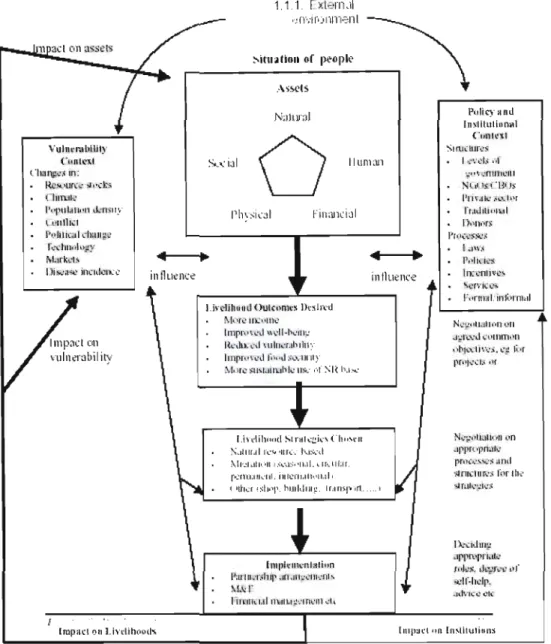
Applying the asset vulnerability framework to housing policy: The issues of housing and livelihood
- Impact of changed location
- Economic reconstruction of communities
- Changes to the status of housing assets
In terms of the asset vulnerability framework, such households may have experienced a reduction in their housing wealth overall. In the Bay Research and Consultancy Services' report, it is mentioned that social capital consists of relationships with. This has a number of potential consequences for low-income households, all of which affect their vulnerability and the value of their social capital assets.
Conclusion
The option of a holistic approach would be important to ensure that, despite the peripheral location of low-income housing projects, housing projects must adhere to sustainability principles if the project is planned and developed holistically. That is why the research is used as a guideline. Thus, when examining the impact of the peripheral location of low-income housing on beneficiary households, systems theory is important to understand the effects of micro, immediate and macro environments on beneficiary households and the community as a whole. The implications, therefore, are that the holistic development approach would be the most appropriate approach to decide whether or not the peripherality of low-income projects has a negative impact on the beneficiary households.
CHAPTER THREE
Slum Clearance Programme
The municipality is in the process of planning phase 2 & 3 of the slum clearance program with the approval of the DoH. To accommodate many of the households to be relocated, 20 Greenfield projects have been identified for implementation. The total cost of the program in terms of grant allocation will be in the region of R2.9 billion (eThewkini Municipality, 2001).
Welbedacht East Project
It is located in the far south of the wider Pinetown area and represents part of the first phase of Durban's slum clearance programme. Municipality designation commenced and was completed under the Development Facilitation Act of 1995. The old Phase lA, which was to be designated through the Private Township Board under the Ordinance Act, was canceled and incorporated into the new project.
Data findings
The final yield of this project will be approximately 4,900 households based on the detailed urban plan, although the initial release was 5,200 units. For the purpose of this study, the focus will be on those who were resettled from other areas outside the Welbedacht or Demat areas. Ever since its inception, there have been mixed feelings about the location of this project.
Research Analysis
- Survey question naires
- Interviews
- Interview with Faizal Seedat: Manager - Land for Housing - Metro Housing Unit
- Interview with Logan Moodley - Deputy Head - Public Transport Planning, ETA
- Interview with Ms Thandi Gwala, a member of Youth Cultural Club
20 respondents (33%) moved from Esithebeni which is one of the areas of KwaGijima informal settlement located in Lamontville Township. The question was raised whether the issue of public transport was considered before the decision was made regarding the location of the project. On the issue of public transport, considering the location of the project, he said that the project was not well located.
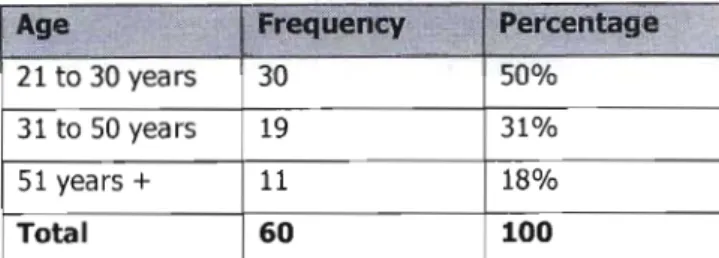
Conclusion
CHAPTER FOUR
- The eThekwini Housing Informal settlement Strategy
- Overview of the Compact City Approach
- The socio-economic impact of the relocation
- Access to social services
- Livelihoods
- Public transportation
- General perception of beneficiary households
- Conclusion
The findings and analysis of the data on the Welbedacht East community indicate that their relocation from Clairwood, Lamontville KwaGijima-eSithebeni and the Ark had a serious and detrimental impact on the quality of life of residents. Comparing where they lived with the benefits they enjoyed in Welbedacht East, the physical situation of the resettlement site is highly unsatisfactory. Finally, the displacement of people from the informal settlements of Clairwood, Lamontville, KwaGijima-eSithebeni and the displacement of the Ark communities reveal two sets of shortcomings in the way in which eThekwini Municipality's Slum Clearance Program was implemented in respect of the study area.
CHAPTER FIVE
Conclusions
The premise is that relocation is not necessarily harmful to the economic well-being of the resettled recipient households and thus the notion that the project. Research findings: The research findings illustrate that moving poor people to the peripherally located low-income housing projects actually increases travel time and transportation costs. The assessment of Welbedacht East has been successful as the project in many ways shows indicators of being one of the peripherally located projects where transport services and facilities are scarce or non-existent.
Recommendations
This means that more compact urban design, with higher housing densities and the development of multifunctional habitats, will reduce the need to travel and improve the quality of life and access to urban amenities. This would be relatively cheap to implement and would have large transport subsidy savings even within the current housing project location. It preserves social structures and the safeguards that exist in the family and society.
General conclusion
It is important that a social package (shelter, health, schools, facilities and employment opportunities) is as accessible as possible to all who intend to benefit. The general conclusion is that it is important that officials of the Housing Unit in the municipality understand how, and why unplanned relocation can affect those who are supposed to be intended beneficiaries. The variety of such supporting services, as well as their delivery, varies from project to project, so it is difficult to make a general statement about what should be offered.
CSRR Report 2004 “Cost-Benefit Comparative Assessment of Low-Income Housing Locations” (Housing Finance Resource Program Report). 34; A decade of democracy: housing, services and land in South Africa "British paper for the South African delegation. The problematic intersection of integrated development planning and integrated transport planning in contemporary South Africa".
APPENDICES
- Where have you been living before moving into these houses?
- How was the household proximity to the inner city centre or areas of work?
- Was this household previously living together, and would you say access to areas of work or income was relatively easy or difficult where
- Does the cost of living here differ from where you previously lived?
- How has moving to Welbedacht East affected access to employment and income?
- Where people have had to change their place of work, has this been the result of increased travelling cost to work place?
Did this household previously live together and would you say that access to areas of work or income was relatively easy or difficult where access to areas of work or income was relatively easy or difficult where the household lived previously. Does the housing unit cooperate or cooperate with your department in determining the suitability of the land with respect to public transportation for low-income housing projects. Have you had a chance to comment on public transport issues prior to the WE location?
